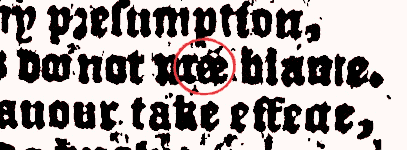
STC 25440
UMI ID#99854909
Author: Whitney, Isabella.
Title: A sweet nosgay, or pleasant posye

With regard to the ligatured double "e" that appears on images 19 and 24 (and probably elsewhere), I see no reason not to follow the usual rules in this case. The two applicable instructions are:
1. "Ligatured characters ... should be recorded as two separate characters. Ignore the ligature." This means that the initial basic representation should be "ee". If there were no accent on the characters, this would be it. But there is an accent, so go to rule 2:
2. "Acute, circumflex, and grave accents on vowels should be recorded with the standard ISO character entities (à, etc.)" This means that the final representation should be "ée" That is, your option "c."
This book appears to use doubled ligatured vowels to indicate long vowels generally. On the same pages, I see several instances of ligatured double "o". For instance, three lines down from the "mee" on image 27 are two "oo"s:
<L>good <HI>DIDO</HI> doo thy best:</L>